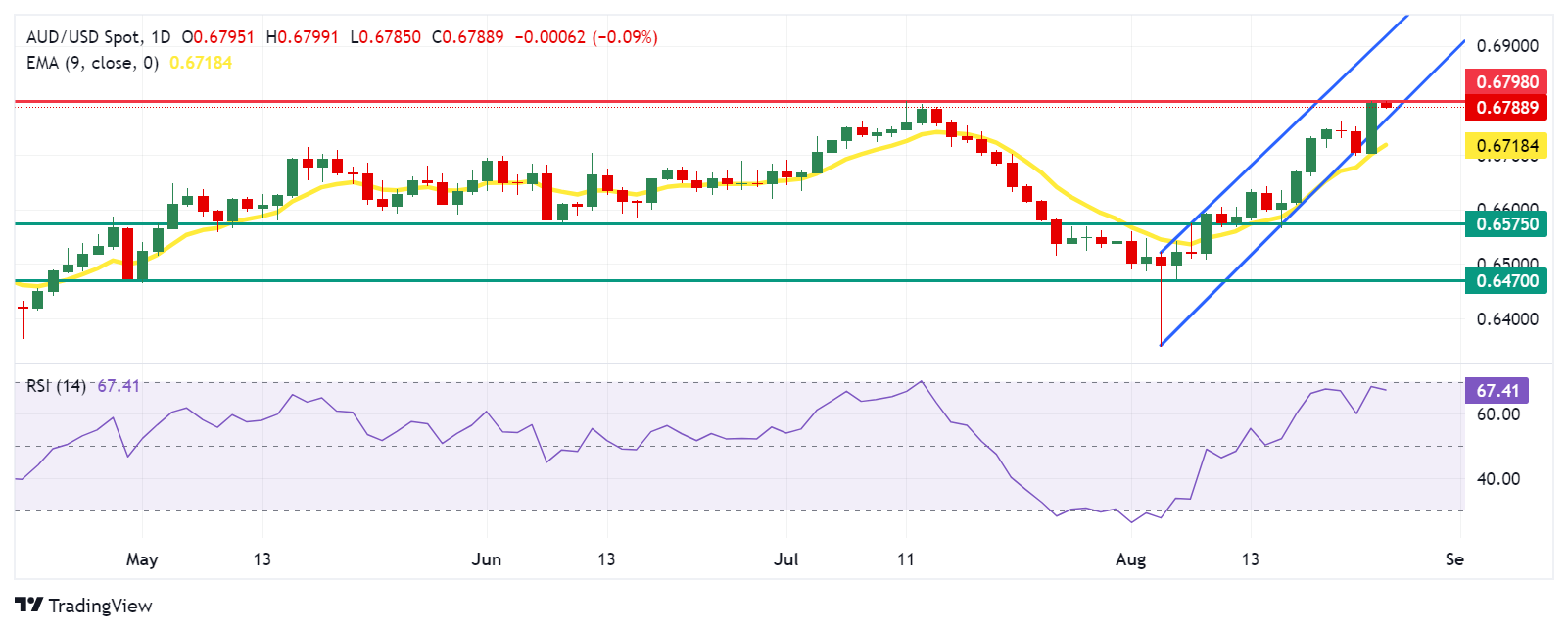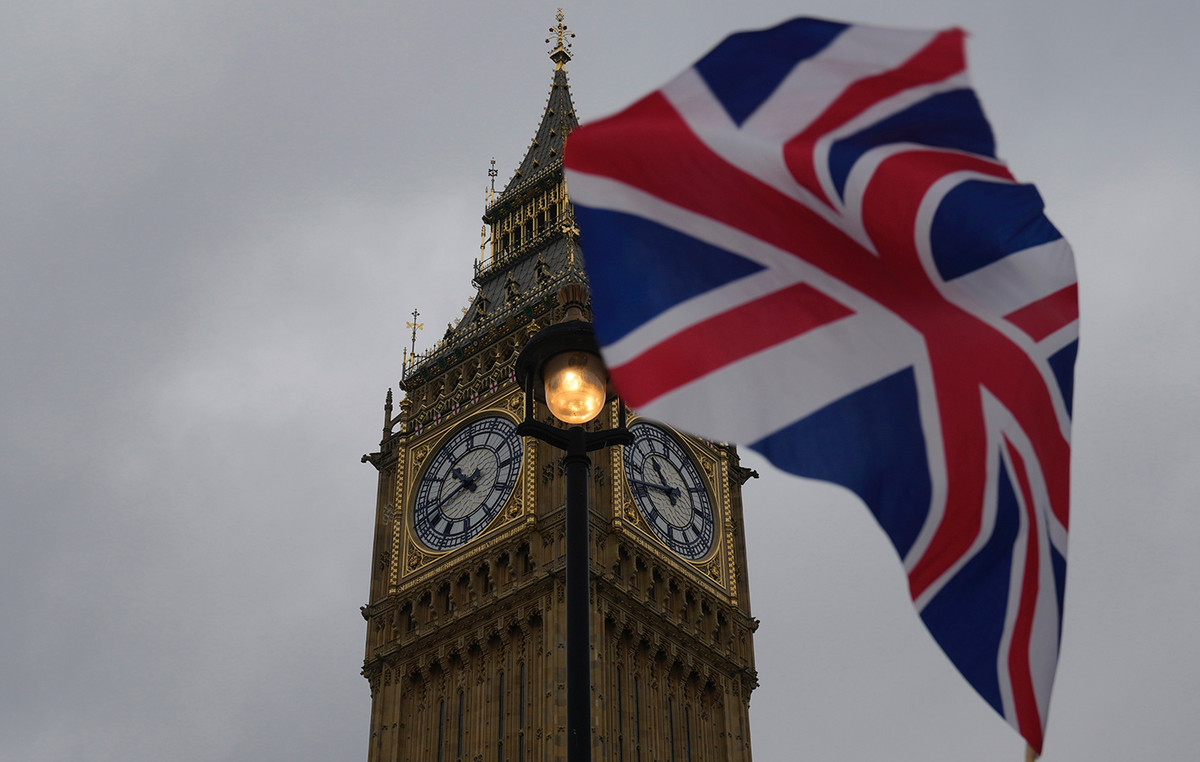- Australian Dollar falls despite risk sentiment following dovish comments from Fed Chair Powell.
- The AUD downside may be limited due to hawkish sentiment around the RBA.
- The US dollar is losing ground due to rising expectations of a 25 basis point rate cut in September.
The Australian Dollar (AUD) is lower, still holding around a seven-month high of 0.6798 on Monday. However, the AUD/USD pair gained ground on rising risk sentiment following US Federal Reserve (Fed) Chairman Jerome Powell’s dovish speech at the Jackson Hole Symposium on Friday.
The Australian dollar also received support from hawkish sentiment around the Reserve Bank of Australia (RBA) regarding its policy outlook. The recent RBA minutes showed that board members agreed that a rate cut is unlikely anytime soon. In addition, RBA Governor Michele Bullock expressed that the Australian central bank will not hesitate to raise rates again to combat inflation if necessary.
The US Dollar (USD) is depreciating on increasing odds of a rate cut in September. According to the CME FedWatch tool, markets now fully anticipate at least a 25 basis point (bp) rate cut by the Federal Reserve at its September meeting.
Fed Chairman Jerome Powell told the Jackson Hole Symposium: “The time has come to tighten policy.” However, Powell did not specify when rate cuts would begin or their likely magnitude.
Daily Market Wrap: Australian Dollar Lowers Despite RBA’s Bold Stance
- Philadelphia Fed President Patrick Harker said Friday that the U.S. central bank’s approach to interest rate adjustments should be “methodical,” noting that policymakers plan a series of rate cuts over the remainder of 2024 as the U.S. central bank prepares for a dovish shift, according to Bloomberg.
- Chicago Fed President Austan Goolsbee said Friday that the Fed has been generally successful in achieving its goals and that inflation should continue to move toward the U.S. central bank’s target range. Policy is now at its tightest point of the entire hiking cycle. Everything we wanted to happen to get rates lower has happened, according to Reuters.
- The US Composite PMI edged down to 54.1 in August, a four-month low, from 54.3 in July, but remained above market expectations of 53.5. This suggests that business activity in the US continues to expand, marking 19 consecutive months of growth.
- Australia’s Judo Bank Composite Purchasing Managers’ Index (PMI) rose to 51.4 in August from 49.9 in July. The increase marks the fastest expansion in three months, driven by improved performance in the services sector despite a sharper contraction in manufacturing output.
- The FOMC minutes from its July policy meeting indicated that most Fed officials agreed last month that they would likely cut their benchmark interest rate at the next meeting in September as long as inflation continued to cool.
- On Tuesday, RBA minutes suggested that board members had considered a rate hike earlier this month before ultimately deciding that holding current rates would better balance risks. In addition, RBA members agreed that a rate cut is unlikely anytime soon.
Technical Analysis: Australian Dollar Rises to Seven-Month Highs Around 0.6800
The Australian Dollar is trading around 0.6790 on Monday. The daily chart analysis shows that the AUD/USD pair has returned to the ascending channel, suggesting a strengthening of the bullish bias. However, the 14-day Relative Strength Index (RSI) is reaching near the 70 mark, supporting the ongoing bullish momentum.
In terms of resistance, the AUD/USD pair is testing the seven-month high of 0.6798. A break above this level could lead the pair to explore the region around the upper boundary of the ascending channel at the level of 0.6910.
On the downside, the AUD/USD pair can find support around the lower boundary of the ascending channel at the level of 0.6770, followed by the nine-day exponential moving average (EMA) at the level of 0.6718. A break below the nine-day EMA could weaken the bullish bias and put downward pressure on the pair to navigate the region around the retracement level at 0.6575, followed by another retracement level at 0.6470.
AUD/USD: Daily Chart
Australian Dollar PRICE Today
The table below shows the Australian Dollar (AUD) exchange rate against major currencies today. The Australian Dollar was the weakest currency against the Japanese Yen.
| USD | EUR | GBP | JPY | CAD | AUD | NZD | CHF | |
|---|---|---|---|---|---|---|---|---|
| USD | -0.00% | 0.04% | -0.33% | -0.03% | 0.11% | 0.00% | -0.15% | |
| EUR | 0.00% | -0.02% | -0.32% | -0.01% | 0.02% | 0.02% | -0.12% | |
| GBP | -0.04% | 0.02% | -0.42% | -0.06% | 0.03% | -0.03% | -0.17% | |
| JPY | 0.33% | 0.32% | 0.42% | 0.33% | 0.53% | 0.57% | 0.29% | |
| CAD | 0.03% | 0.01% | 0.06% | -0.33% | 0.12% | 0.07% | -0.12% | |
| AUD | -0.11% | -0.02% | -0.03% | -0.53% | -0.12% | -0.00% | -0.15% | |
| NZD | -0.01% | -0.02% | 0.03% | -0.57% | -0.07% | 0.00% | -0.15% | |
| CHF | 0.15% | 0.12% | 0.17% | -0.29% | 0.12% | 0.15% | 0.15% |
The heatmap shows percentage changes of major currencies. The base currency is selected from the left column, while the quote currency is selected from the top row. For example, if you choose the Australian Dollar from the left column and move along the horizontal line to the US Dollar, the percentage change shown in the chart will represent the AUD (base)/USD (quote).
Australian Dollar FAQs
One of the most important factors for the Australian Dollar (AUD) is the level of interest rates set by the Reserve Bank of Australia (RBA). Since Australia is a resource-rich country, another key factor is the price of its largest export, iron ore. The health of the Chinese economy, its largest trading partner, is a factor, as is inflation in Australia, its growth rate and the Trade Balance. Market sentiment, i.e. whether investors are betting on riskier assets (risk-on) or seeking safe havens (risk-off), is also a factor, with risk-on being positive for the AUD.
The Reserve Bank of Australia (RBA) influences the Australian Dollar (AUD) by setting the level of interest rates that Australian banks can lend to each other. This influences the level of interest rates in the economy as a whole. The RBA’s main objective is to maintain a stable inflation rate of 2%-3% by adjusting interest rates up or down. Relatively high interest rates compared to other major central banks support the AUD, and the opposite for relatively low ones. The RBA can also use quantitative easing and tightening to influence credit conditions, with the former being negative for the AUD and the latter positive for the AUD.
China is Australia’s largest trading partner, so the health of the Chinese economy greatly influences the value of the Australian Dollar (AUD). When the Chinese economy is doing well, it buys more raw materials, goods and services from Australia, which increases demand for the AUD and drives up its value. The opposite occurs when the Chinese economy is not growing as fast as expected. Therefore, positive or negative surprises in Chinese growth data often have a direct impact on the Australian Dollar.
Iron ore is Australia’s largest export, worth $118 billion per year as of 2021 data, with China being its main destination. The price of iron ore can therefore be a driver of the Australian dollar. Typically, if the price of iron ore rises, the AUD rises as well, as aggregate demand for the currency increases. The opposite occurs when the price of iron ore falls. Higher iron ore prices also tend to lead to a higher probability of a positive trade balance for Australia, which is also positive for the AUD.
The trade balance, which is the difference between what a country earns from its exports and what it pays for its imports, is another factor that can influence the value of the Australian dollar. If Australia produces highly sought-after exports, its currency will gain value solely because of the excess demand created by foreign buyers wanting to purchase its exports versus what it spends on buying imports. Therefore, a positive net trade balance strengthens the AUD, with the opposite effect if the trade balance is negative.
Source: Fx Street
I am Joshua Winder, a senior-level journalist and editor at World Stock Market. I specialize in covering news related to the stock market and economic trends. With more than 8 years of experience in this field, I have become an expert in financial reporting.








